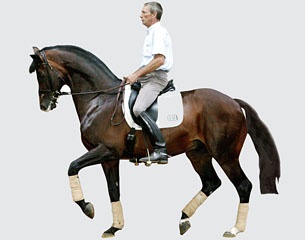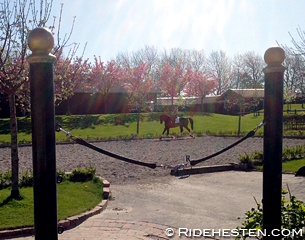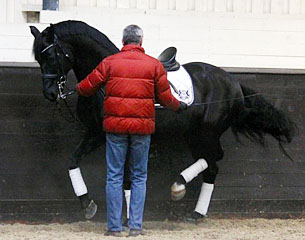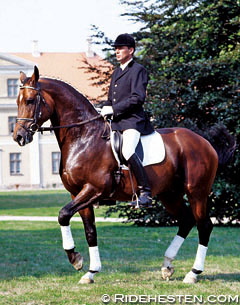
"If there were a Piaffe World Championship, in which each participant had ten horses to work with, I am sure that I would win," said a confident Jorgen Olsen says with a twinkle in his eye and a warm smile. A bold statement from a humble horseman who knows his worth. That ́s okay, when you know what you are talking about!
"During the last few months I have trained 25 new younger horses in piaffe and re-trained an additional 15. A couple of them were completely rejected as Grand Prix horse. All were successful except for one, as we are still working on how to do it. The request for piaffe training came when Poul Fabricius Bjerre put up a video clip on Facebook, in which I taught the horse piaffe during 3-4 sessions. After I removed the clip, riders began calling and booking lessons. It is a little peculiar, because I have trained and educated a lot of Grand Prix horses over the last 40 years and have tought many horses to do piaffe and passage. So because I have always done it, I didn't suddenly decide to be a master of piaffe. I do it because it's fun and it doesn' t take a lot of training sessions before the horse think it's fun to”.
Piaffe must be fun!
"For me there is nothing more beautiful than a happy horse in piaffe with the ears forward carrying the tail in a relaxed way. On the other hand there is nothing worse than an angryn unhappy horse doing piaffe and it is sad when the horse is tense and anxious," Olsen stated.
 Jorgen distinguishes three types of piaffe: the happy piaffe, the angry piaffe and the stress-on-the-spot piaffe. "When you begin teaching the horse piaffe, it is important to understand that it is not a natural movement for it. You don’t see a horse doing piaffe in a paddock as opposed to passage, as the horse naturally shows when it is showing off in the field. When we teach the horse piaffe steps from the ground holding the reins and engage it from behind, the horse can neither come forward nor backwards, then it chooses the only thing it can do, to elevate the steps upward. In the learning process, it is absolutely essential that the horse understand the connection between the piaffe steps and praise. A lot of riders think piaffe is hard on the horse but it is not if you teach the horse piaffe with a light contact on the reins and ears forward. When the horse has found the rhythm is it just standing there rocking and it becomes easier for the horse as it gets stronger. Practice makes perfect, also for the horse."
Jorgen distinguishes three types of piaffe: the happy piaffe, the angry piaffe and the stress-on-the-spot piaffe. "When you begin teaching the horse piaffe, it is important to understand that it is not a natural movement for it. You don’t see a horse doing piaffe in a paddock as opposed to passage, as the horse naturally shows when it is showing off in the field. When we teach the horse piaffe steps from the ground holding the reins and engage it from behind, the horse can neither come forward nor backwards, then it chooses the only thing it can do, to elevate the steps upward. In the learning process, it is absolutely essential that the horse understand the connection between the piaffe steps and praise. A lot of riders think piaffe is hard on the horse but it is not if you teach the horse piaffe with a light contact on the reins and ears forward. When the horse has found the rhythm is it just standing there rocking and it becomes easier for the horse as it gets stronger. Practice makes perfect, also for the horse."
Praise, stick and sugar
Jorgen begins piaffe training at a very slow pace when horses or five or six years old and have learnt to accept the half halt. "There is not one particular way to teach a horse piaffe. It depends on the horse's age, exterior, temperament and training history. Some learn best by being worked in hand from the ground, others under saddle. When I'm working with a new horse, it is all about the horse trusting me and I get a lot of help through a box of sugar cubes. As soon as the horse takes a small step in the right direction I praise it and give it a lump of sugar. When the horse start to expect the sugar cube from my hand we are well on the way. Trust and praise are essential for my work. As soon as the horse has learned to take one step towards piaffe I know that it will also take the next ten steps."
 Jorgen admits he doesn't like the word "whip" as it reminds him of torture. He prefers using the term "stick" instead considering it an aid. "It should be used with ease and with timing, and usually only in the learning phase. On the more sensitive horses it is often enough to simply snap your fingers. Some trainers choose to work with the horse from the ground in long lines when they teach the horse piaffe. I am not sure about this. I find it hard to see from behind what the horse is doing because you look only at the hind legs. I therefore prefer to stand next to the horse, where I can see the whole picture and what the horse is doing."
Jorgen admits he doesn't like the word "whip" as it reminds him of torture. He prefers using the term "stick" instead considering it an aid. "It should be used with ease and with timing, and usually only in the learning phase. On the more sensitive horses it is often enough to simply snap your fingers. Some trainers choose to work with the horse from the ground in long lines when they teach the horse piaffe. I am not sure about this. I find it hard to see from behind what the horse is doing because you look only at the hind legs. I therefore prefer to stand next to the horse, where I can see the whole picture and what the horse is doing."
Olsen said that many assume the horse should take short steps forward in the beginning of the learning process because it makes it easier on the horse. He begs to differ. "It is much harder for the horse to keep its balance in the piaffe and at the same time move forward, it cannot sit down and go forward at the same time! The horse must keep impulsion, but stay with the rider. From the beginning I teach the horse piaffe on the spot because of the fact that it must sit. Work from the ground is generally good for the horse, it creates trust and at the same time it schools the horse. The horses that I have had in piaffe training becomes more mature, the lazy horse sharper and generally easier for the rider to ride afterwards”.
Elevated steps
Olsen regrets that judges do not seem to recognize a proper classical piaffe anymore and overscore elevated steps instead of rewarding properly executed piaffes in sport.
“Horses bred today are more nervy than in the past. It is clearly an advantage when you teach them piaffe," said Jorgen. "However, I am not in favour of the unnatural elevated steps that characterizes some Dutch horses we saw at the European Championship in Denmark last year. These horses do not use their back in the piaffe they simply can ́t carry it and it annoys me that the judges can't see this. A horse that shows very elevated frontlegs and doesn't use its back has nothing to do with classical piaffe. A horse with less knee bend can learn to piaffe just as well as a horse with very high knees. When the horse's self carrige becomes strong enough it comes naturally up in the knees”.
Training horses with creative steps
 Olsen has been called to duty to fix many of those wrongly trained piaffes, which he calls "creative steps" instead of piaffe. "I have been asked to re-educate horses that don't piaffe but do all sorts of creative steps or nothing at all. For example, I worked with a horse that when you collected it in trot, it did something that looked like pacing. Another horse crossed the front legs in an extreme way, and another failed to lift the legs at all," said Jorgen. "You then get a horse that is scared and wants to run away and some horses might just resign and freeze. This is often because they have experienced too much pressure and whip. There are many different reasons and problems."
Olsen has been called to duty to fix many of those wrongly trained piaffes, which he calls "creative steps" instead of piaffe. "I have been asked to re-educate horses that don't piaffe but do all sorts of creative steps or nothing at all. For example, I worked with a horse that when you collected it in trot, it did something that looked like pacing. Another horse crossed the front legs in an extreme way, and another failed to lift the legs at all," said Jorgen. "You then get a horse that is scared and wants to run away and some horses might just resign and freeze. This is often because they have experienced too much pressure and whip. There are many different reasons and problems."
Jorgen focuses on helping the horse understand what it actually is the trainer wants. "It usually takes two to six training sessions to get the horse to play along and one training session can last 10 minutes to half an hour. It is important to keep an eye on the horse's mood, attention and expression in the eye and most importantly to stop, while it's fun."
Gunnar Andersen alias Gyro Gearloose
The ability to analyse the horse's problems in piaffe and having the tools to alter it, is not something one can learn from a textbook "and it is not something kids should play with," Jorgen added. The more advanced work with horses should be done by trainers who have many years of experience training different horses.
"My own mentor was the legendary trainer Gunnar Andersen, whom I had the pleasure of working with over the years," said Jorgen. "I called him Gyro Gearloose. He was a little offended by this and thought I made fun of him, until I told him that it was because he was so good at finding solutions for different horses and problems. He was very skilled at analyzing the horse and at making suggestions and training strategies to improve their work."
 While's Gunnar' strength mainly lay in improving a horse's canter, Jorgen has a talent for training piaffe and passage. "We complemented each other really well," he added. "Today I get inquiries from coaches and trainers who ask for my help and appreciate it. It's fun and I'm glad to help. We all have our strengths, so we might as well use each other. I think in general that we have become much better at this."
While's Gunnar' strength mainly lay in improving a horse's canter, Jorgen has a talent for training piaffe and passage. "We complemented each other really well," he added. "Today I get inquiries from coaches and trainers who ask for my help and appreciate it. It's fun and I'm glad to help. We all have our strengths, so we might as well use each other. I think in general that we have become much better at this."
Jorgen Olsen is renowned Danish Grand Prix rider, horse dealer and breeder. He is a former Danish Professional Dressage Champion and works from Poul Fabricius-Bjerre's and the Finnish team rider Mikaela Lindh's Dressage Stable Solyst. Now based in Birkerod near Copenhagen, Jorgen has trained and exported horses as well as given clinics in most parts of the world. He discovered talented horses and breeding stallions such as Suna, Milan, Rambo, Robin and Electric.
Text by Heidi Moller, edited by Eurodressage
Photos © private - Ridehesten
Related Links
Milan Sold to Austria
Milan DVH Selected for Danish Grand Prix Talent Squad
Robin DVH Sold to Sofie Jeppesen
Mix Max Sold to Jill De Ridder
What's Happening: February 2010 - Part 2